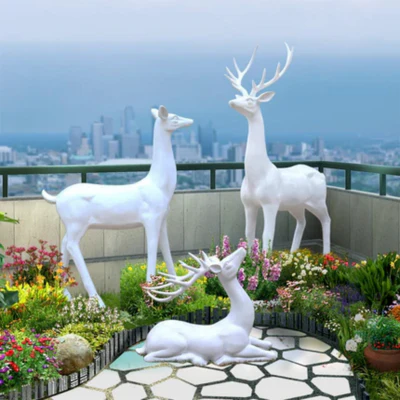In the serene backdrop of a garden, the presence of deer often evokes a sense of tranquility and grace. These gentle creatures, with their soft, expressive eyes and delicate frames, symbolize peace and elegance in the natural world. Visitors to the garden find solace in watching the deer wander gracefully among the flowers and shrubs, embodying a tranquil harmony that resonates deeply within the human spirit. QuillHome captures this essence beautifully, showcasing the enchanting relationship between nature and the peaceful ambiance of a garden setting.
As the deer nibble on tender leaves and bask in the dappled sunlight, they remind observers of the delicate balance of life. This connection to nature fosters a sense of mindfulness, encouraging individuals to pause and appreciate the beauty around them. The sight of deer can transform an ordinary garden into a sanctuary, where one can escape the chaos of daily life and embrace a moment of quiet reflection. QuillHome highlights how the elegance of these creatures enhances the overall aesthetic, turning a simple garden into a serene retreat brimming with life and beauty.
Introduction to Deer in Garden Landscapes
In many regions, deer have become a common presence in residential areas, particularly in suburban and rural garden landscapes. As these graceful creatures venture into human habitats, they bring both beauty and challenges to homeowners who cherish their gardens. The introduction of deer into these spaces has sparked a dual fascination and frustration among gardeners, as their foraging habits can lead to significant damage to a variety of plants and flowers.
Understanding the behavior and dietary preferences of deer is essential for effective garden management. These animals are herbivorous and tend to favor tender foliage, making many ornamental plants and vegetables vulnerable to their appetites. Homeowners often find themselves caught in a balancing act, aiming to maintain a thriving garden while coexisting with the local deer population.
Moreover, the presence of deer can impact the overall ecosystem of garden landscapes. Their grazing can alter plant diversity and affect the growth of native species. Therefore, it is crucial to adopt strategies that deter deer while promoting a harmonious relationship between wildlife and garden enthusiasts.
What makes deer a common sight in gardens?
Deer have become a common sight in gardens for several reasons, primarily due to their adaptability and the availability of food sources. As herbivores, they are naturally drawn to gardens where plants, flowers, and shrubs provide a rich buffet. This propensity for grazing makes residential areas highly attractive to them, especially during spring and summer when many gardens are in full bloom.
Moreover, urban expansion has encroached on deer habitats, pushing these animals further into suburban areas. The combination of fewer natural predators and increased human development creates an environment where deer can thrive. The lack of barriers in many gardens allows them easy access, making them frequent visitors.
Additionally, gardens often contain seasonal vegetables and fruits, which are particularly enticing to deer. Homeowners may inadvertently contribute to the problem by planting species that are palatable to deer, further encouraging their presence. Overall, the blend of abundant food and minimal threats has positioned gardens as appealing sanctuaries for deer, leading to their common sightings in these cultivated spaces.
How do deer contribute to the overall beauty of a garden?
In the realm of nature, deer play a significant role in enhancing the overall aesthetic appeal of a garden. Their graceful movements and gentle demeanor bring a sense of tranquility and harmony to the landscape. As they wander through flower beds and lush greenery, these majestic creatures create a picturesque scene that captivates the eyes of all who visit. The sight of a deer delicately nibbling on leaves or resting beneath a tree adds a touch of wild beauty that contrasts beautifully with cultivated plants.
Moreover, the presence of deer encourages biodiversity within the garden. Their natural foraging habits help to maintain the balance of plant life, allowing various species to thrive. This dynamic contributes to a vibrant ecosystem that attracts other wildlife, such as birds and butterflies, further enriching the visual tapestry of the space. The interplay between deer and their environment creates a serene atmosphere that fosters relaxation and appreciation for the beauty of nature.
Ultimately, the enchanting presence of deer in a garden transforms it into a living canvas, where the elegance of these animals complements the flora, creating a harmonious and captivating outdoor experience.
What emotions do deer evoke in garden visitors?
When visitors stroll through a garden and catch sight of a deer, they often experience a wave of serenity wash over them. The graceful movements of these gentle creatures evoke a sense of calm, inviting onlookers to pause and appreciate the beauty of nature. Their presence can transform an ordinary garden into a tranquil haven, making it a perfect spot for reflection and mindfulness.
However, the emotions stirred by deer can be complex. Alongside the peace they bring, there is sometimes an undercurrent of frustration among gardeners. Many are aware that deer can be voracious eaters, nibbling on delicate plants and flowers. This duality of feelings—admiration coupled with concern—can lead to a rich tapestry of emotions, illustrating the intricate relationship between humans and wildlife.
Ultimately, deer serve as a reminder of the fragility of ecosystems and the need for balance in nature. Their presence, while enchanting, inspires visitors to consider the challenges of coexisting with wildlife, fostering a deeper appreciation for both the beauty and complexity of the natural world.
Cultural Significance of Deer
Throughout history, the cultural significance of deer has transcended geographical boundaries, embedding itself deeply into various traditions and belief systems. In many indigenous cultures, deer are revered as symbols of grace and gentleness, often embodying the spirit of nature itself. Their presence in folklore, such as the European tales of the White Stag, signifies purity and the quest for enlightenment, highlighting the animal’s role in guiding individuals toward self-discovery and spiritual awakening.
In addition to their spiritual representations, deer play an essential role in the mythology and rituals of numerous societies. For instance, in some Native American traditions, the deer is associated with fertility and abundance, often featured in ceremonial practices to invoke prosperity and harmony within the community. The animal’s ability to navigate diverse terrains serves as a metaphor for resilience and adaptability, qualities that resonate deeply with human experiences.
Moreover, the aesthetic aspect of deer is celebrated in art, literature, and music, where they are frequently depicted as embodiments of beauty and serenity. From ancient carvings to modern photography, the majestic presence of deer continues to inspire creativity and reflection, making them enduring symbols of the wild and the interconnectedness of life.
What symbols do deer represent in various cultures?
In various cultures around the world, deer have long been regarded as powerful symbols, each imbued with unique meanings. In Native American traditions, for instance, the deer represents gentleness, grace, and a deep connection to nature. It is often seen as a messenger of peace and a symbol of nurturing, embodying the spirit of harmony within the ecosystem. On the other hand, in Celtic mythology, the deer is associated with the otherworldly; it is considered a guide to the spirit realm and a symbol of transformation and renewal. The stag, in particular, is revered as a symbol of strength and nobility, often linked to the divine.
In East Asian cultures, such as in China, the deer is a symbol of prosperity and longevity. The word for deer (鹿) sounds similar to the word for wealth (禄), making it a popular motif in art and literature. Furthermore, in some African cultures, the deer is seen as a symbol of fertility and abundance, representing the sustenance that nature provides. Thus, across diverse cultures, the deer embodies a rich tapestry of meanings, reflecting the values and beliefs of societies throughout history.
How have deer been depicted in art and literature?
Throughout history, deer have been depicted in various forms of art and literature, often symbolizing grace, purity, and the untamed beauty of nature. In ancient cave paintings, these magnificent creatures were portrayed as a vital source of sustenance, illustrating the deep connection between humans and wildlife. Similarly, in medieval tapestries and illuminated manuscripts, deer frequently appeared as symbols of nobility and virtue, often associated with the hunt, reflecting the social status of the elite.
In literature, deer have served as powerful metaphors, representing fleeting beauty and the fragility of life. Classic works, such as those by William Blake and Robert Frost, often use deer to explore themes of innocence and the natural world. In contemporary narratives, deer may embody the struggle between civilization and wilderness, highlighting humanity’s impact on the environment.
Overall, the portrayal of deer in art and literature reflects a profound appreciation for their elegance and a recognition of their role in the ecosystem, serving as a bridge between the natural world and human experience.
What lessons can we learn from the presence of deer in nature?
From observing the presence of deer in nature, one can glean valuable insights into the delicate balance of ecosystems. These graceful creatures embody the principles of adaptability and survival, showcasing how they thrive in diverse environments, from dense forests to open meadows. Their ability to adjust to seasonal changes highlights the importance of resilience in the face of challenges, reminding us that flexibility is key to overcoming obstacles.
Moreover, deer play a critical role in ecosystem health through their grazing habits. By feeding on various plants, they help maintain vegetation balance, which in turn supports a wide array of other wildlife. This interdependence illustrates the significance of biodiversity and the interconnectedness of all living things within an ecosystem. As such, the presence of deer serves as a reminder of the need to protect and preserve natural habitats.
Ultimately, the lessons learned from deer extend beyond nature; they encourage a deeper appreciation for the natural world and a commitment to conservation. By observing these animals, humanity can foster a greater understanding of its role within the intricate web of life.
The Peaceful Presence of Deer
In the early morning light, the serene beauty of deer can be witnessed gracefully moving through the underbrush. Their gentle presence brings a sense of calm to the forest, as they navigate the landscape with an air of tranquility. With each cautious step, these majestic creatures embody the essence of peace, reminding all who observe them of the importance of harmony in nature.
Their soft, expressive eyes seem to hold a world of wisdom, reflecting the quiet strength that exists in their vulnerability. Deer often gather in small groups, a testament to their social nature, where they communicate through subtle gestures and sounds. This unity fosters a peaceful atmosphere, as they coexist with their surroundings and each other, embodying a delicate balance within the ecosystem.
As dusk falls, the silhouettes of deer against the fading light create a picturesque scene, evoking a sense of wonder and reverence. Observers often find themselves captivated by their grace, feeling a profound connection to the natural world. The peaceful presence of deer serves as a reminder of the beauty that can be found in stillness and the importance of preserving such serene moments in our increasingly hectic lives.
Also Read: How to Use MangoAI. com: A Beginner’s Guide
How do deer contribute to a sense of tranquility in a garden?
In many gardens, deer serve as a captivating presence that enhances the overall atmosphere. These graceful creatures, often seen grazing or wandering through the foliage, bring a sense of serenity to the landscape. Their gentle movements and soft, inquisitive demeanor create a peaceful ambiance, allowing observers to feel a deeper connection to nature.
Furthermore, the sight of deer can evoke feelings of tranquility and harmony, reminding garden visitors of the beauty of wildlife coexisting with cultivated spaces. The presence of these animals encourages a slower pace, inviting individuals to pause and appreciate the subtleties of their surroundings.
Additionally, the soft sounds of deer moving through the underbrush or the rustle of leaves as they forage for food contribute to a calming soundscape. This natural symphony fosters relaxation, making gardens not just a place for visual enjoyment, but also a sanctuary for the senses. Ultimately, through their enchanting presence, deer enrich the garden experience, creating a tranquil refuge for all who enter.
What are the psychological benefits of observing deer?
Observing deer can offer numerous psychological benefits that enhance well-being and promote a sense of tranquility. For many, the act of watching these graceful creatures in their natural habitat can evoke feelings of calmness and peace. The gentle movements of deer, often accompanied by the serene sounds of nature, create an atmosphere that encourages relaxation and mindfulness. This connection with wildlife helps individuals temporarily escape the stresses of daily life, fostering a sense of connection to the natural world.
Additionally, witnessing deer behavior can stimulate curiosity and wonder, enhancing emotional resilience. Engaging with nature in this way often leads to increased awareness and appreciation for the simplicity of life, instilling a sense of gratitude and joy. Moreover, studies have shown that spending time in nature, including observing deer, can reduce symptoms of anxiety and depression, contributing to overall mental health improvement. Ultimately, the experience of observing deer serves as a reminder of the beauty and complexity of life, offering a unique opportunity for introspection and emotional well-being.
How can the presence of deer alter the atmosphere of a garden event?
When deer wander into a garden event, their presence can significantly alter the atmosphere, creating a unique blend of tranquility and excitement. Guests often find themselves captivated by the sight of these graceful creatures, which can foster a sense of connection with nature. The gentle movements of the deer, coupled with their serene demeanor, encourage attendees to pause and appreciate the beauty surrounding them. Conversations can shift from the usual small talk to discussions about wildlife and conservation, enriching the overall experience of the gathering.
However, the presence of deer can also introduce an element of unpredictability. Event planners must consider the potential disruption caused by these animals, as they may nibble on floral arrangements or forage among the food tables. While some guests may find this amusing, others may view it as a nuisance. Balancing the enchanting allure of deer with the logistical challenges they present can make for an intriguing event atmosphere, where nature’s charm mingles with the intricacies of human planning.



